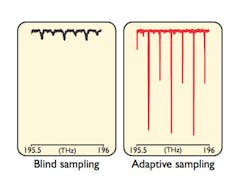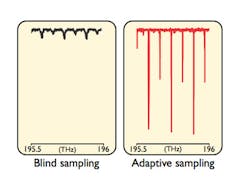Spectroscopy method IDs, quantifies molecular species in real time
A team of scientists at the Laser Spectroscopy Division of the Max Planck Institute of Quantum Optics (MPQ; Garching, Germany), Ludwig Maximilian University (LMU; Munich, Germany), and the Institut des Sciences Moléculaires d’Orsay (France) has developed a real-time identification and quantification method for molecules. The work has implications in areas such as bioimaging, where real-time recording of molecular spectra is important.
Related: Wavelength-modulated Raman spectroscopy enables tissue assessment in real time
Dual-comb spectroscopy has demonstrated exciting potential for ultra-rapid recording of complex molecular spectra. When compared to state-of-the-art instrumentation used in Fourier transform spectroscopy, it shortens recording times from seconds to microseconds. Dual-comb spectroscopy without moving parts harnesses two laser frequency combs (coherent sources that emit a regular train of ultrashort pulses) to perform interferometric measurements, but it is difficult to synchronize the two lasers within the required precision. Recognizing this, the research team developed a new approach that enabled them to use unstabilized free-running femtosecond lasers without sacrificing performance. By generating proper clock signals, they compensated for laser short-term instabilities by electronic signal processing only.
The possibility of using femtosecond lasers without any sophisticated stabilization scheme considerably eases the implementation of a dual-comb spectrometer. "It should facilitate applications to real-time sensing," comments Takuro Ideguchi, who just completed his doctoral dissertation partly based on this experiment. "Dual-comb spectroscopy holds much promise for new approaches to molecular physics and our scheme of adaptive sampling is a key to their efficient implementation. Enhanced sensitivity for weak concentrations is within reach with the development of mid-infrared frequency combs, while nonlinear dual-comb spectroscopy provides intriguing prospects for applications ranging from bioimaging to precision spectroscopy."
Full details of the work appear in the journal Nature Communications; for more information, please visit http://dx.doi.org/10.1038/ncomms4375.
-----
Follow us on Twitter, 'like' us on Facebook, and join our group on LinkedIn
Subscribe now to BioOptics World magazine; it's free!

